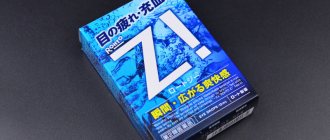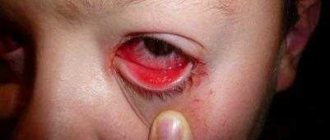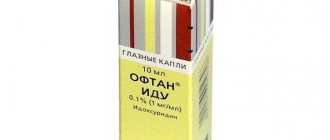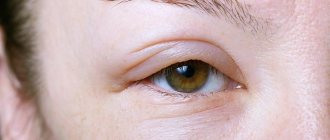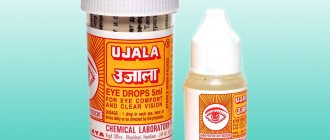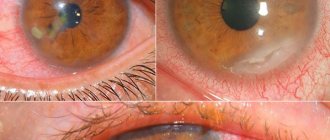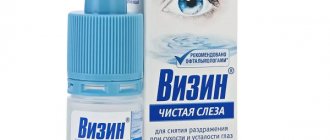Travatan eye drops are used for open-angle glaucoma. The disease is associated with increased intraocular pressure due to impaired fluid outflow. Open-angle glaucoma is dangerous because it has a latent course; its symptoms may appear when irreversible changes occur in the eye. Vision gradually deteriorates, headaches appear, and rainbow rings appear when looking at the light. To slow down the development of the disease, Travatan drops are prescribed to normalize blood pressure.
Composition and release form
The ophthalmic agent Travatan is an opalescent liquid for instillation into the eyes, colorless and odorless. A slightly yellowish tint is possible, which does not affect the medicinal properties of the drug. The active substance of the drops is a chemical compound - travoprost. 1 ml of liquid contains 40 mcg of substance. Additionally, the eye drops contain components that improve absorption and the effect of travoprost and preserve the shelf life of the product:
- propylene glycol;
- macrogol glyceryl hydroxystearate;
- boric acid;
- propylene glycol;
- mannitol;
- sodium chloride;
- purified water;
- sodium hydroxide, hydrochloric acid (the composition may contain either two substances or one);
- polydronium chloride.
The solution is poured into dropper bottles made of polypropylene. The volume of one bottle of Travatan is 2.5 ml. The drug is sealed in a foil bag and cardboard packaging with instructions inside.
Scheme for using “Travatan”
When instilling Travatan into the eyes, it is recommended to follow the recommendations listed below:
- Before using the medicine, wash your hands thoroughly with antibacterial soap;
- to avoid infection entering the eyes, the dropper on the Travatan bottle should not be touched with your hands;
- If necessary, it is recommended to carefully remove excess medication with a cotton pad;
- When using Travatan in combination with other eye drops, you must take a break of at least five minutes between installations.
The drug should be instilled into the affected eye once a day. Installation of drops should be carried out shortly before bedtime.
pharmachologic effect
Travatan eye drops are classified as antiglaucoma ophthalmic agents. The active substance is a synthetic analogue of prostaglandin F2a. Travoprost reduces intraocular pressure, which is one of the causes of glaucoma. The therapeutic effect is achieved by increasing the rate of outflow of aqueous humor through the trabecular meshwork and uveoscleral pathways.
The active substance selectively excites the receptors of the ciliary body, promoting the outflow of fluid inside the eye located between the cornea and the lens. This mechanism of action reduces intraocular pressure. Travatan drops do not affect the production of intraocular fluid. High blood pressure begins to decrease approximately 2 hours after instillation. The peak effect of the drug occurs after 12 hours. After a single instillation, the reduced pressure can persist for up to 1 day.
Who are the drops contraindicated for?
Travatan eye drops should not be used:
- with high sensitivity to the components of the drug;
- during pregnancy;
- during lactation;
- persons under 18 years of age.
Pregnancy and lactation
The use of the drug while pregnant is prohibited, as well as during breastfeeding. As for the latter, treatment by the mother during breastfeeding with Travatan is possible only as a last resort, when the therapeutic effect will prevail over the threat of side effects for the child.
Side effects
Immediately after installation of Travatan, a certain discomfort may be felt in the eyes, which will gradually decrease. Increased eye irritation may occur, resulting in tearing, burning and redness of the eye membranes.
Important! Antiviral eye drops: instructions, drugs, prices and reviews
Visual acuity may decrease, and the cornea and eyelids may swell.
Travatan may also cause:
- keratitis;
- conjunctivitis;
- uveitis;
- macular edema.
In rare cases, the following diseases may develop:
- headache;
- angina pectoris;
- cardialgia;
- changes in blood pressure;
- exacerbation of stomach ulcers;
- stool disorder
- depression;
- pain in muscles, joints;
- bronchitis, bronchospasm;
- high blood cholesterol;
- hyperpigmentation;
- enuresis.
Before using Travatan, the patient should be informed that the drug may, with long-term use, contribute to:
- change in eye color;
- eyelid skin pigmentation;
- thickening and growth of eyelashes.
Please note: instructions for Zovirax ointment. Description and reviews of the ointment.
In the news (more details) analogues of Vitabact eye drops.
Symptoms and treatment of eye cataracts! https://moezrenie.com/bolezni/khrustalika/katarakta-chto-eto.html
Overdose
The use of Travatan in recommended dosages according to the doctor’s recommendations and instructions; cases of overdose have not been described.
If the frequency of instillation exceeds the required dose, the following reactions are possible:
- irritation of the mucous membrane of the eye;
- conjunctival hyperemia;
- hyperemia of the episclera.
Symptomatic therapy is used as treatment.
Pharmacokinetics
Travoprost penetrates the cornea of the eye, undergoes a hydrolysis reaction, turning into a biologically active form in the form of a free acid. Its maximum level in blood plasma is detected 15-25 minutes after instillation in an amount of 25 pg/ml or less. The chemical is quickly removed from the blood plasma, and within 60 minutes its level decreases to a threshold that is not always detectable from 10 pg/ml and below.
The exact time of elimination of the ophthalmic drug could not be determined, since its presence in the general bloodstream is extremely small. The method of excretion of the active substance occurs due to its metabolic process, which is similar to the metabolism of endogenous prostaglandin. Travoprost in the form of free acid along with metabolites is eliminated from the body through the kidneys in the urine.
Indications and contraindications for use
Travatan drops are prescribed for open-angle glaucoma, increased ophthalmotonus in combination with high intraocular pressure in people over 18 years of age. Restrictions on use:
- breast-feeding;
- pregnancy;
- age under 18 years;
- increased sensitivity, individual intolerance to chemicals in eye drops.
Caution when using is necessary for people with aphakia, pseudophakia due to a rupture of the lens membrane or intraocular lens. Drops are prescribed with caution in cases of high probability of cystoid macular edema, iritis, uveitis, and the presence of acute inflammatory eye diseases.
Read more Instructions for using Ofloxacin drops
Mechanism of action and contraindications
The main active ingredient of the drug is a prostaglandin analogue, which acts with prostaglandin FP receptors. The competitive interaction causes an increase in the outflow of intraocular fluid and, accordingly, a decrease in pressure and a weakening of the symptoms of glaucoma. The therapeutic effect becomes noticeable 2 hours after use and persists throughout the day.
After instillation of the drug into the conjunctival sac, travoprost is concentrated in the anterior chamber of the eye, turns into an active form and begins to act. A small amount of the drug is absorbed into the systemic circulation.
Travatan is used to lower intraocular pressure in open-angle glaucoma or increased intraocular tone. For secondary or angle-closure glaucoma, Travatan is prescribed only in combination with other drugs. Usually these are alpha- and beta-blockers, miotics, carbonic anhydrase inhibitors. There are no absolute contraindications to the use of prostaglandins for the treatment of glaucoma.
Contraindications:
- hypersensitivity to components;
- age under 18 years;
- inflammation in the iris, choroid;
- increased risk of papilledema;
- aphakia (absence of lens);
- pseudophakia (artificial lens);
- damage to the lens capsule;
- diabetic retinopathy (long-term therapy with prostaglandins increases the risk of diabetic macular edema);
- after surgical treatment of corneal pathologies, the drug can provoke rejection and swelling (all types of keratoplasty, transplantation of donor material);
- in the first weeks after cataract surgery (increases the risk of cystoid macular edema).
Instructions for use of Travatan drops
The product is intended only for local use - instillation into the eyes. The standard dosage is 1 drop into the conjunctival sac 1 time per day in the evening or before bedtime. To maintain a therapeutic dose of the active substance in the eye, instillation is recommended to be carried out at the same time. If the instillation is missed, next time instill 1 drop; there is no need to increase the amount. Apply no more than 1 drop per day. The duration of treatment is determined by the ophthalmologist.
To reduce the likelihood of negative systemic reactions, after instillation it is recommended to lightly press the nasolacrimal duct in the area of the inner corner of the eye (closer to the bridge of the nose).
Thus, the amount of active substance entering the general bloodstream will decrease, and its level in the eye will increase. In case of renal or liver dysfunction of any severity, no dose adjustment is required.
Before instillation, you must wash your hands with soap. Tilt your head slightly back, pull the lower eyelid slightly down, add 1 drop of Travatan. During the procedure, it is not recommended to touch the tip of the bottle to the eyelashes, eyelids, skin or touch it with your hands, otherwise pathogenic flora may enter and the solution may become contaminated. In order for the drug to be evenly distributed over the surface of the eye, it is necessary to make circular movements with the eyeballs or blink quickly.
Directions for use and doses
The drug is used topically.
Prescribe 1 drop into the conjunctival sac of the eye (eye) 1 time/day, in the evening. To reduce the risk of developing systemic side effects, it is recommended to clamp the nasolacrimal duct after instillation of the drug by pressing in the area of its projection at the inner corner of the eye.
If a dose of the drug is missed, treatment should be continued with the next dose. The daily dose of the drug should not exceed 1 drop into the conjunctival sac of the eye 1 time/day.
Travatan® can be used in combination with other local ophthalmic drugs to reduce intraocular pressure. In this case, the interval between their use should be at least 5 minutes.
If Travatan® is prescribed as a replacement for another ophthalmic drug for the treatment of glaucoma, the latter should be discontinued and the use of Travatan® should be started the next day.
Dose adjustment is not required in patients with mild to severe hepatic impairment, as well as in patients with mild to severe renal impairment (with CC less than 14 ml/min).
Use of Travatan in pregnant and lactating women
The manufacturer indicates in the instructions that there is no data on the effect of Travatan on the body of a pregnant woman or fetus or limited access. It is unknown whether the active ingredient passes into breast milk. All prostaglandins, including their analogues, are biologically active compounds that can penetrate the body by being absorbed through the skin.
Given this fact, pregnant women and nursing mothers should avoid contact with these substances so that they do not come into contact with the skin. In case of contact, rinse the area with plain tap water. No studies have been conducted on the effect of drops on human fertility or the condition of the fetus; experiments on animals did not show any negative reactions. In animal studies of the active component, travoprost, evidence was obtained of an adverse effect on reproductive function.
Since there is no data confirming the safety of Travatan drops for pregnant women and lactating women, the use of the product for this category of people is prohibited. If during the feeding period the use of drops is necessary, the baby is transferred to artificial feeding. To maintain lactation, milk is expressed. You can return to breastfeeding after stopping the medication.
Features of using Travatan
Before using the drug, you must read the instructions and consult your doctor. It is very important to pay attention to the features of treatment with Travatan. Ignoring them is fraught with a decrease in the effectiveness of the drug and the occurrence of complications.
The active components of Travatan can cause an increase in the concentration of melanosomes in pigment cells, which will provoke a change in eye color. This is a slow but irreversible process. When the drug is instilled into one eye, heterochromia (different eye shades) occurs. The consequences of changing eye color have not been studied.
Some patients experience darkening of the skin around the eyes and mouth when treated with Travatan. The drug is able to influence eyelashes, change their number and length. The consequences of these deformations have also not been studied.
The active components of Travatan can be absorbed into the bloodstream upon contact with the skin. In this case, it is recommended to rinse the area with plenty of water. The drug is prescribed with caution for infectious or inflammatory damage to the structures of the eye.
Prostaglandins, including Travatan, are not used in the treatment of congenital glaucoma in children. The drug is prescribed to pregnant women only in cases where the risk of complications is higher than the potential danger to the fetus. Travatan and analogues are not prescribed during lactation: the active substances enter the bloodstream and breast milk.
Pregnant and lactating women can be treated with Travatan only as prescribed by a doctor and strictly for medical reasons. A negative effect of active substances on the development of the fetus cannot be ruled out when the components of Travatan are absorbed into the mother’s bloodstream.
If the patient uses contact lenses, they must be removed before instillation and wait 15 minutes after the procedure. Benzalkonium chloride, which is part of Travatan, can destroy the structure of soft contact lenses. If you do not remove the lenses, the permeability of the medicine through the cornea will decrease and a strong burning sensation will occur.
After instilling the drops, slight blurring of vision may occur. Immediately after use, do not perform potentially hazardous work, as well as actions requiring attention and concentration.
Side effects of Travatan drops
Most often among patients using the drug, side effects manifested themselves in the form of hyperpigmentation of the iris and conjunctival injection. Possible rare and extremely rare negative reactions from the organ of vision:
- pain, itching, burning in the eyes;
- corneal erosion;
- erythema of the eyelids;
- discomfort in the eyes;
- blepharitis;
- dry eye syndrome;
- swelling of the periorbital area;
- inflammation of the conjunctiva;
- cataract or its exacerbation;
- decreased visual acuity;
- increased sensitivity to light;
- punctate keratitis;
- discoloration of eyelashes;
- increased eyelash growth and thickening;
- blurred vision;
- asthenopia;
- retraction of the eyeballs;
- eye hypoesthesia;
- rainbow circles when looking at a light source;
- folliculosis of the conjunctiva;
- mydriasis
Negative reactions from the cardiovascular system can manifest themselves as a feeling of heartbeat, a decrease in heart rate, a decrease or increase in blood pressure, discomfort in the chest, bradycardia, tachycardia.
For the lungs, side effects may include breathing problems, throat irritation, cough, and nasal congestion. With bronchial asthma, there may be attacks of shortness of breath or worsening of the disease. From the gastrointestinal tract: stool disturbance, nausea, dry mouth, discomfort in the abdomen, exacerbation of chronic ulcers. An extremely rare manifestation of the urinary system is urinary incontinence.
Read more Drops Beresh Plus - instructions, reviews for children
Possible pain in muscles, joints, tinnitus, dizziness, headache, anxiety, exacerbation of diseases caused by Herpes simplex. Extremely rare manifestations of the skin and subcutaneous tissues:
- skin discoloration;
- excessive or abnormal growth of vellus hair, changes in its structure;
- skin itching;
- contact, allergic dermatitis;
- excessive pigmentation of the skin in the area around the eyes;
- skin rashes;
- erythema.
If these symptoms occur, you should stop using the drug and consult a doctor.
Possible negative reactions
While using Travatan, many patients note the development of the following local and systemic side effects:
- Pathologies of the organ of vision: transient hyperemia of the conjunctiva develops, sensation of a foreign body in the eye, decreased visual acuity, blurred vision, clouding of the lens, itching and burning, inflammation of the eyelids, conjunctiva, lacrimation or increased dryness of the mucous membrane, minor subconjunctival bleeding;
- Disorders of the cardiovascular system: development of arterial hypotension or hypertension, pain in the heart area, which is characterized by a compressive nature, bradycardia, increased cholesterol levels in the bloodstream, which contributes to the occurrence of atherosclerotic vascular lesions;
- From the urinary system: urinary incontinence, urinary tract infections;
- Nervous system disorders: headaches, depression, general anxiety;
- Pathologies of the musculoskeletal system: pain in the back, in the joints;
- From the respiratory organs: inflammation of the paranasal sinuses, bronchi;
- Disorders of the digestive organs: unstable stools, increased gas formation.
While using Travatan, a flu-like condition may occur, when the patient's temperature rises, aches in the joints, muscles, and general weakness appear.
Overdose
Despite the huge list of possible side effects, symptoms of overdose are extremely rare if you use ophthalmic drops as prescribed by a doctor or instructions. In case of accidental ingestion of Travatan solution, symptomatic therapy is indicated, depending on the negative reactions that occur. If you accidentally drink the entire bottle, drink water and induce vomiting, consult a doctor. If you instill excess drops, rinse your eyes with warm tap water. After contact with skin, rinse the area with plain water.
special instructions
When instilling, it is not recommended to touch the drop dispenser to the skin, eyelashes, eyelids or touch it with your hands, so as not to contaminate the solution. Impaired visual acuity and temporary blurred vision are possible, so it is not advisable to drive behind the wheel immediately after instillation. People working with mechanical machines or driving vehicles must take into account that the drug can cause a side effect in the form of visual impairment, which may not appear immediately after instillation.
The ophthalmic drops contain propylene glycol, macrogol glyceryl hydroxystearate, which can irritate the skin; therefore, it is undesirable for the solution to come into contact with the skin. When wearing lenses, they are removed before instillation and put on after the procedure 15 minutes later. The drug is used with caution when removing the lens or disrupting the structure of the lens.
Travatan drops are often instilled into both eyes; when instilled in one eye, heterochromia (different iris colors) is possible due to the absorption of the drug into the general bloodstream.
Before using the drops, you must check the expiration date and the integrity of the bottle. It is prohibited to use expired medication.
Dosage and rules of use of Travatan
Travatan eye drops are instilled into the cavity of the conjunctival sac. The usual dose is a drop once a day, preferably in the evenings. After instillation, it is recommended to close the eyelids or pinch the nasolacrimal ducts. This will reduce systemic absorption of the drug and avoid side effects.
The duration of therapy is determined by the treating ophthalmologist. Increasing the dose or increasing the frequency of instillations may reduce the effectiveness of the drug. One bottle of Travatan is usually enough for a month of daily use.
One instillation per day is very convenient for patients. In this mode it is much more difficult to forget about the procedure. If a dose is missed, treatment is continued with the next one, that is, the next day. When replacing medications, the new one should be used the day after the previous one is discontinued.
When using several glaucoma medications at the same time, you need to wait an interval of 5-7 minutes. If you instill medications one after another, washout will occur. Typically, doctors combine drugs for daytime use (Azopt, Timolol, Dorzopt) and evening use (prostaglandins).
Increasing the dosage of Travatan is not recommended. In practice, cases of overdose have not been reported, but if severe discomfort occurs, the eyes should be rinsed. You can drive behind the wheel 15-20 minutes after instilling the drug, as it causes temporary blurred vision.
Analogs
An analogue of Travatan, containing the same active ingredient - Travapress drops. Drugs with similar effects, different composition:
- Xalatan - the active substance is latanoprost, which reduces intraocular pressure in adults and children over 1 year of age. Prescribed for open-angle glaucoma and high ophthalmotonus.
- Okumed is an inexpensive analogue in action, the price is about 70 rubles. The active ingredient is timolol. A beta blocker reduces both normal and high pressure inside the eye. The effect can be noticed after 20 minutes. Used for open-angle, congenital, and secondary glaucoma.
- Pilocarpine is a cheap analogue, costing about 30 rubles. The active ingredient is similar to the name. Used for acute attacks of glaucoma, corneal abscesses, retinal vein thrombosis and other conditions and diseases.
- Azarga - antiglaucoma combined drops containing timolol, brinzolamide. Relatively expensive - average price 1000 rubles. Prescribed to reduce pressure in the eye, in case of ineffectiveness of products containing one substance in the composition.
- Azopt is an antiglaucoma suspension with the active ingredient bronzolamide. Indications are similar to Travatan.
- Timolol contains a chemical substance similar to its name. Used to reduce pressure in closed-angle (as an additional agent), open-angle, and congenital glaucoma.
- Fotil is a combined antiglaucoma solution for instillation. Contains 2 chemicals: pilocarpine, timolol. Used in cases where a combination of two components is necessary: various types of glaucoma, conditions after eye surgery.
Read more Instructions for using Mezaton eye drops
You can replace Travatan only on the recommendation of a doctor; independent use can aggravate the course of glaucoma and other diseases of the organ of vision.
When can you take...
"Travatan" is prescribed for the treatment (as a rule, we are talking about a complex version) of the following pathologies of the organs of vision:
- open-angle glaucoma;
- high or too high level of eye muscle tone.
Travatan is also used to reduce intraocular pressure.
This product is highly effective
It is worth noting that the medicine is permitted, but with caution, under the following circumstances:
- the patient may develop macular edema;
- there are problems with the lens of the eye (absent (aphakia) or present, but artificial (pseudophakia), damaged (posterior capsule injury));
- the presence of acute iritis or uveitis.
